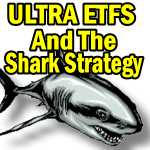The Shark Option Trading Strategy is one of the more popular and profitable strategies for active traders. Part of the reason for its success is the small amount of capital required for each trade. The other is the short time periods in which trades are open placing capita at risk. When capital is at risk for short periods, capital being used is better protected and it is available immediately for the very next Shark Option Trade. Recently a couple of investors working together applying the Shark Option Trading Strategy posted to the members’ only forum that they were back testing and paper trading the TZA Ultra Short ETF using this strategy.
Since many investors aside from members are also using this strategy having bought the “4 Investment Strategies For Ultra ETFs” strategy paper in my store here, I felt I should post their comments and my answers and make them available to all investors.
Here is what they posted.
Investor’s Questions On The Shark Option Trading Strategy
Hi,
We have been doing a lot of reading on the shark option strategy we recently purchased. Still mostly back testing and paper trades.
The market appears overbought at the moment so we took a look at the 3x bears. The TZA is great for a young shark like us. It is relatively cheap and offers weekly options. I know it isn’t following a commodity like recommended, but we are fairly comfortable trading the smallcaps (RUT).
TZA fast stochastic readings have caught my attention but EMA’s not fully caught up yet.
Taking a bit of a gamble and went ahead and bought the April (53) 11 calls for $.80
I figure its fairly low risk and I can always sell some weekly 12 calls against it to reduce my cost basis along the way.
My Answers
While the Shark Option Trading Strategy is designed for highly volatile commodity type ETFs such as the AGQ which is the ETF demonstrated in the strategy paper, I have used and back tested the Shark Strategy on each of the following Ultra Bear ETFs. Here are the results for investors using this strategy.
SDS -S&P Ultra Short 2 X ETF
This ETF is a 2 times ETF which I tested for about a year two years ago. While it is only a two times ETF I still had reasonably good results. Liquid on this ETF for at the money and just out of the money options is reasonable good. In a downturn volumes are large and easy to trade. The problem with the SDS ETF is the profits were not as large and sometimes the movements not as pronounced so the Shark Strategy sometimes did not give clear signals on exiting.
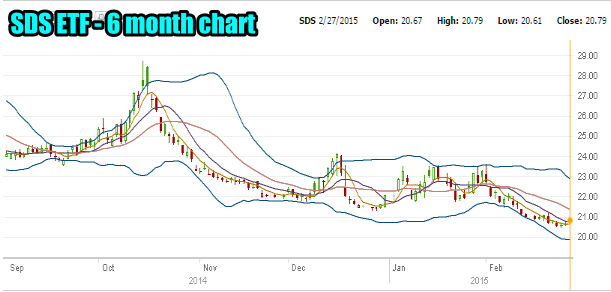
SDS ETF 2 X Ultra Short
SDOW – Dow Ultra Short 3 X ETF
This is the Ultra Short ETF that I trade in regularly. I back tested this ETF in 2012 and did some trades in 2013 using the Shark Strategy with very good results. However in periods when the market is trending higher volumes were not high. For example on Friday options traded were few which considering the Dow fell over 80 points should have increased the interest in this ETF. Therefore some times I found that while the trade was perfect, there was not enough volume so either entering the trade or exiting it were difficult to do. Because it took too long at times to exit a trade I often did not get the full profit that had been available should I have been able to exit quickly. Overall then, I think for the Shark Strategy this is a poor choice.
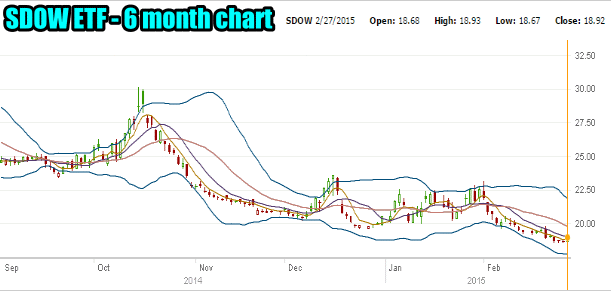
SDOW ETF 3 X Ultra Short
SPXU -S&P Ultra Short 3 X ETF
The SPXU was another Ultra short ETF that I tested in 2013 and tried some trades in 2014. Again results were somewhat mixed due to volumes among the options. This past Friday volumes were incredibly poor which is what I found most often when trying the Shark Strategy with the SPXU.
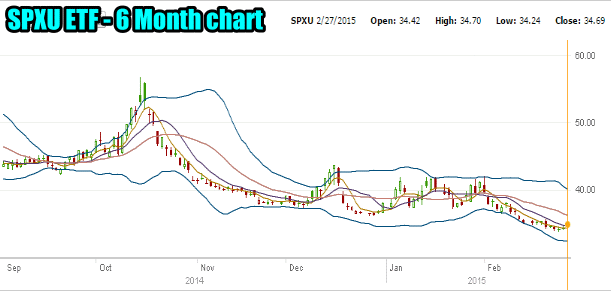
TZA – Derision Daily Small Cap Bear 3 X ETF
This is the ETF the investors are discussing in their post. The TZA follows the small caps based on the Russell 2000 index, the RUT. I back tested this ETF in 2012 and I did a number of trades in 2013. The ETF had a reverse split on April 2 when 1 shares was issued for every 4. This improved the returns from the Shark Strategy and gave it wider swings making the Shark Strategy signals clearer. When you look at the chart below for the past 6 months you can see that once again the ETF is falling into the low double digits around 10.81. I would expect at some point soon another reverse split will be done. I found volumes to be good enough to be able to get in and out of a trade quickly which allowed me to earn reasonably good returns.
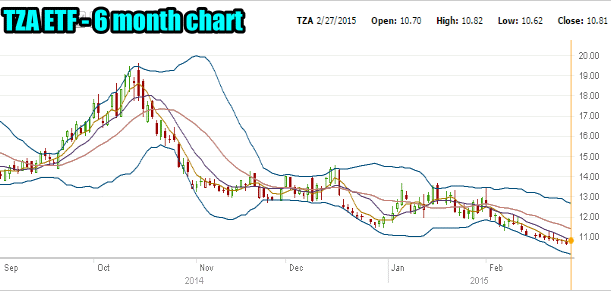
TZA ETF 6 month chart
AGQ -ProShares Ultra Silver
In general I found the AGQ to be superior to all four of the above however primarily because volumes were better at most times in the options. This made entering and exiting trades at the time of signals from the Shark Strategy, easy and quick.
I have back tested a number of other Ultra ETFs with the Shark Strategy. These include:
ERX – Direxion Energy Bull 3X – low options volume most of the time
ERY – Direxion Energy Bear 3X – low options volume most of the time
UPRO -ProShares UltraPro S&P500 3X – medium options volume most of the time. Reasonably good results were achieved in back tests.
SOXL – Direxion Daily Semiconductor Bull 3X – low volume but surprisingly decent results on small quantities of options
SOXS – Direxion Daily Semiconductor Bear 3X – low volume but surprisingly decent results on small quantities of options
There are other Ultra ETFs I am still backtesting. As I find others I will post them for investors who are using the Shark Option Trading Strategy.
For investors interested in learning the Shark Option Trading Strategy, it is part of the 4 Investment Strategies for Ultra ETFs strategy paper which can be reviewed and purchased in my store through through this link.
Disclaimer: There are risks involved in all investment strategies and investors can and do lose capital. Trade at your own risk. Stocks, options and investing are risky and can result in considerable losses. None of the strategies, stocks or information discussed and presented are financial or trading advice or recommendations. Everything presented and discussed are the author’s own trade ideas and opinions which the author may or may not enter into. The author assumes no liability for topics, ideas, errors, omissions, content and external links and trades done or not done. The author may or may not enter the trades mentioned. Some positions in mentioned stocks may already be held or are being adjusted.

